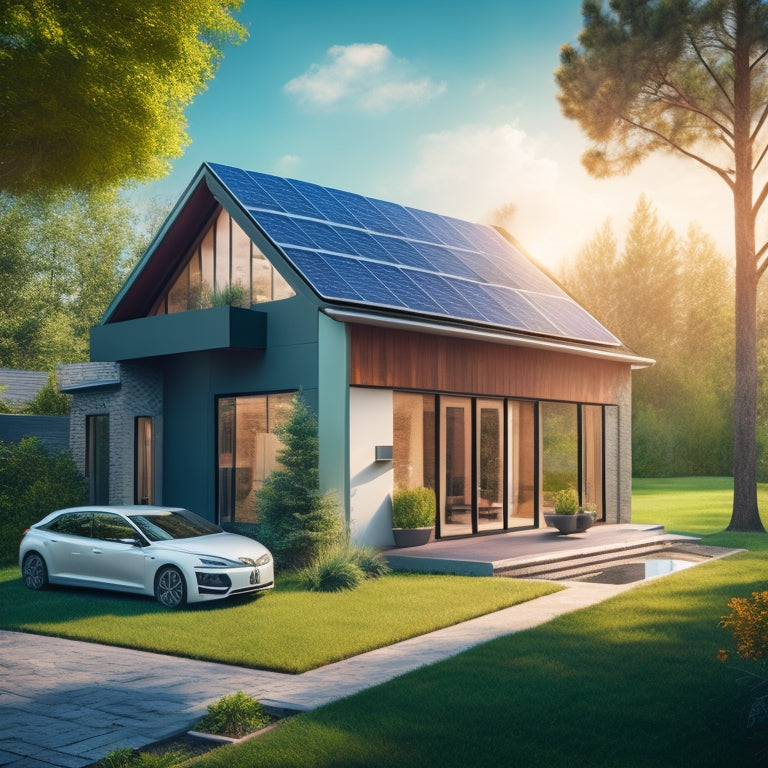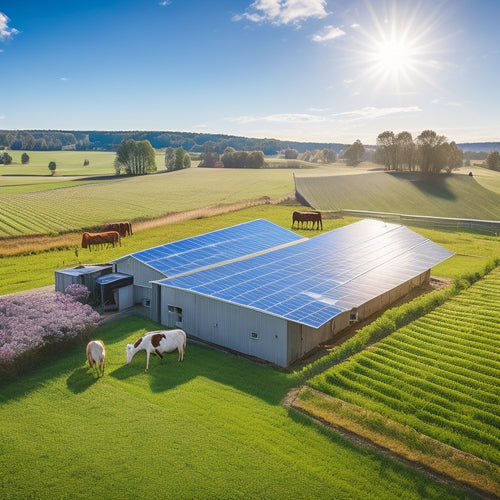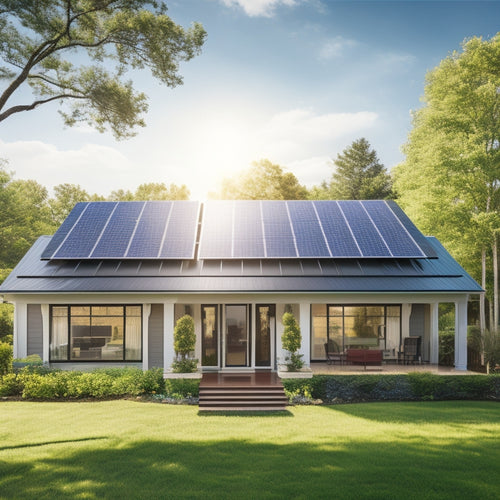
7 Ways to Charge Smarter With Renewable Energy
Share
By adopting renewable energy solutions, you greatly reduce your carbon footprint and gain greater control over your energy consumption, aligning with a sustainable future. You can charge smarter by powering your home efficiently, reducing energy bills dramatically, and achieving true energy independence. Safety features, like emergency protocols and surge protection, provide peace of mind, while expandable and adaptable systems let you scale your energy production to meet changing demands. With renewable energy, you can enjoy low maintenance energy solutions and environmentally friendly charging options. As you investigate these benefits, you'll uncover even more ways to optimize your energy usage and create a more sustainable lifestyle.
Overview
- Invest in advanced battery systems like lithium-ion to optimize energy management and store excess energy for smarter charging.
- Ensure energy independence by generating, storing, and managing renewable energy to reduce reliance on the grid and lower carbon footprint.
- Implement smart technology for energy monitoring to reduce energy waste and consumption by 5-10%, leading to significant cost savings.
- Optimize solar panel tilt to enhance energy output by up to 45% in winter, resulting in more efficient renewable energy harvesting.
- Utilize energy storage capabilities to reduce costs and enhance resilience, allowing for flexible and expandable energy systems that adapt to changing demands.
Powering Your Home Efficiently
Efficiency converges with sustainability when it comes to powering your home, as every watt saved is a watt earned for the planet.
When you invest in renewable energy, you're not only reducing your carbon footprint but also taking control of your energy consumption.
Advanced battery systems, such as those using lithium-ion batteries, detect and store excess energy from renewable sources, allowing you to optimize your energy management.
By streamlining your energy consumption, you'll reduce waste and maximize the benefits of your renewable energy source.
Reduce Energy Bills Dramatically
You can greatly reduce your energy bills by identifying and eliminating energy waste in your home.
By cutting energy waste now, you'll not only slash your utility bills but also lower your monthly expenses.
For instance, optimizing your solar panel array and installation strategic panel tilt can enhance energy output by up to 45% in winter.
Cut Energy Waste Now
Every kilowatt-hour (kWh) of energy wasted translates to a higher utility bill and a larger carbon footprint. You can take control of your energy consumption by identifying areas of waste and making changes. Conducting an energy audit helps you pinpoint where energy is being wasted, and implementing waste reduction strategies can lead to significant savings.
| Waste Reduction Strategies | Impact |
|---|---|
| Replacing inefficient appliances with efficient ones | 10-20% reduction in energy consumption |
| Making behavioral changes, such as turning off lights during peak hours | 5-10% reduction in energy consumption |
| Upgrading insulation to reduce heat loss | 5-10% reduction in energy consumption |
| Implementing smart technology for energy monitoring | 5-10% reduction in energy consumption |
| Shifting to renewable energy sources | 20-50% reduction in carbon footprint |
Slash Your Utility Bills
Cutting energy waste is just the first step in optimizing your energy consumption. Now, it's time to take it to the next level by slashing your utility bills considerably.
You can do this by identifying areas of inefficiency in your home through energy audits. These audits will pinpoint where energy is being wasted, allowing you to make targeted improvements.
By conducting thorough load profiling analysis, you can understand your energy usage patterns and optimize your system configuration to minimize costs.
Additionally, consider taking advantage of solar incentives, which can considerably reduce the cost of switching to renewable energy.
By combining these strategies, you'll be able to dramatically lower your energy bills and enjoy the freedom that comes with being less reliant on the grid.
With the right approach, you can cut your energy costs and start building a more sustainable future.
Lower Monthly Expenses
About 75% of homeowners are overpaying for their energy bills due to inefficient energy consumption. By switching to renewable energy sources and implementing energy-saving strategies, you can considerably lower your monthly expenses.
Start by conducting an energy audit to identify areas of inefficiency in your home. Then, invest in budget-friendly options like energy-efficient appliances, LED light bulbs, and solar panels.
Implement energy-saving tips like turning off lights and electronics when not in use, using power strips, and adjusting your thermostat. These simple changes can lead to dramatic reductions in your energy bills, giving you more financial freedom and peace of mind.
Achieve True Energy Independence
To break free from the grid and employ the full potential of renewable energy, you need an all-inclusive system that can store and manage energy efficiently.
This is where energy autonomy comes into play. By investing in a thorough renewable energy system, you can achieve true energy independence, reducing your reliance on the grid and living a more sustainable lifestyle.
You'll have the power to generate, store, and manage your own energy, giving you the freedom to live life on your own terms.
With a well-designed system, you can enjoy uninterrupted power supply, even during outages, and markedly reduce your carbon footprint.
Safety Features You Can Rely
When you've achieved true energy independence, your focus shifts to ensuring the reliability and safety of your renewable energy system.
You rely on safety features that meet strict safety standards, designed to prevent electrical shock, fires, and other hazards. Your system should have emergency protocols in place, such as automatic shutdowns and alerts, to respond quickly in case of an emergency.
You also need surge protection to safeguard your system from power surges and spikes. With these safety features, you can have peace of mind, knowing your system is protected and reliable.
Expandable and Adaptable Systems
When designing your renewable energy charging system, you'll want to prioritize flexibility and scalability.
A modular system design allows you to add or remove components as needed, while scalable power solutions guarantee you can adapt to changing energy demands.
Modular System Design
Designing a renewable energy system that can adapt to your changing needs is essential, and that's where modular system design comes in. This approach allows you to build a system with modular components that can be easily added or removed as your energy requirements change.
You can start with a small system and expand it as needed, reducing upfront costs and minimizing waste. Modular system design also enables seamless energy integration, allowing you to combine different renewable energy sources, such as solar and wind power, to create a hybrid system that maximizes your energy output.
With modular design, you're free to adapt your system to your unique energy needs, giving you more control over your energy independence.
Scalable Power Solutions
A scalable power solution is essential for any renewable energy system, as it allows you to adapt to changing energy demands without having to replace the entire system.
This adaptability is critical, especially when integrating with the smart grid, where energy demand and supply can fluctuate rapidly. With a scalable solution, you can easily add or remove components as needed, ensuring you're always generating the right amount of power.
Furthermore, many renewable energy incentives, such as tax credits and rebates, are tied to the scalability of your system. By choosing a scalable power solution, you can maximize these incentives and enjoy greater freedom from grid dependence.
Flexible Energy Storage
Your renewable energy system's flexibility hinges on its energy storage capabilities. You need a system that can adapt to changing energy demands and supply. Flexible energy storage solutions enable you to optimize your energy usage, reduce costs, and increase grid resilience.
| Benefits | Features |
|---|---|
| Scalability | Modular design, hybrid energy solutions |
| Adaptability | Energy management systems, demand response programs |
| Cost-effectiveness | Renewable energy incentives, energy storage economics |
Low Maintenance Energy Solution
By opting for renewable energy solutions, you're not only reducing your carbon footprint but also gaining access to low maintenance energy systems that won't drain your wallet or require constant attention.
This means you'll have more time and resources to focus on what matters most to you. With innovative technologies and sustainable practices, renewable energy systems are designed to be self-sufficient and efficient.
They're built to last, with minimal parts that need replacement, reducing the need for frequent repairs. This results in significant cost savings over time.
Plus, many renewable energy systems come with remote monitoring capabilities, allowing you to keep tabs on your energy production and consumption from anywhere.
This level of freedom and flexibility is unparalleled in traditional energy systems.
Environmentally Friendly Charging
As you enjoy the benefits of low maintenance energy solutions, it's time to investigate another advantage of renewable energy: environmentally friendly charging. By embracing sustainable technology and green innovations, you're contributing to a cleaner future.
With electric vehicles on the rise, solar charging is becoming an increasingly popular eco-friendly solution. This shift towards renewable resources marks a significant energy change, with charging infrastructure and battery efficiency playing critical roles.
Smart grids will be essential in supporting this growth, ensuring a seamless and efficient energy supply. By choosing environmentally friendly charging options, you're not only reducing your carbon footprint but also laying the groundwork for a freer, more sustainable tomorrow.
Frequently Asked Questions
Can I Sell Excess Energy Back to the Grid?
You can sell excess energy back to the grid through net metering policies, which allow you to feed surplus energy into the grid and receive credits at energy buyback rates, giving you control over your energy usage and costs.
Are Renewable Energy Systems Eligible for Tax Credits?
You qualify for tax credits when installing renewable energy systems, as they're eligible for federal incentives, offering a 26% credit on qualified expenditures, helping you offset costs and invest in your sustainable freedom.
Do I Need a Battery Backup for My System?
As you commence on your expedition to energy independence, you're wise to wonder: do I need a battery backup for my system? Not necessarily, but it depends on your battery type and system efficiency; consider lithium-ion for peak performance and a smooth changeover to off-grid living.
How Long Does It Take to Install a Renewable Energy System?
You'll typically spend 2-5 days installing a renewable energy system, but this installation timeline can stretch up to several weeks depending on system complexity, permits, and labor availability, so plan ahead to guarantee a smooth shift to energy independence.
Are Renewable Energy Systems Compatible With Smart Homes?
You stroll into your smart home, lights adjusting to your mood, and wonder, "Will my renewable energy system crash the party?" Relax, it's a perfect match! You'll seamlessly integrate your system with energy management systems, ensuring a harmonious flow of green power and smart home integration.
Ready to Buy
You've taken the first step towards a sustainable future by embracing renewable energy. Now, you're charging smarter, powering your home efficiently, and reducing energy bills dramatically. You've achieved true energy independence, relying on safety features that protect you and your family. Your system is expandable and adaptable, requiring low maintenance and minimizing your carbon footprint. By switching to renewable energy, you're not only saving money but also doing your part for the environment. You're living the change you want to see in the world.
Related Posts
-

What Do I Need to Know About Farm Solar Panels
When considering farm solar panels, you need to assess costs, benefits, and technical specifics. Initial investment c...
-

Smart Home Thermostats to Revolutionize Your Space
Smart home thermostats revolutionize your space by providing precise temperature control and optimizing energy saving...
-

Home Solar Installation Cost
You're considering installing solar panels on your home, and the upfront cost is likely the biggest hurdle standing i...


